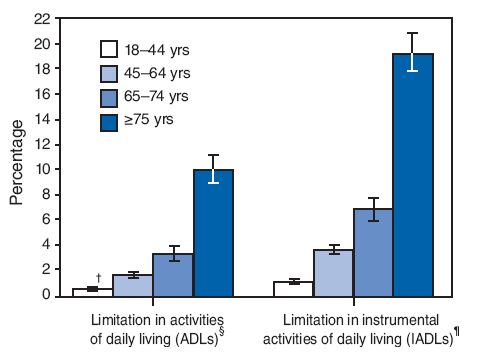Persons using assistive technology might not be able to fully access information in this file. For assistance, please send e-mail to: mmwrq@cdc.gov. Type 508 Accommodation and the title of the report in the subject line of e-mail.
QuickStats: Percentage of Adults with Activity Limitations, by Age Group and Type of Limitation --- National Health Interview Survey, United States, 2008*

* Estimates are based on household interviews of a sample of the civilian, noninstitutionalized U.S. population. Persons with unknown limitation status were excluded from the denominators.
† 95% confidence interval.
§ ADLs are based on response to the question, "Because of a physical, mental, or emotional problem, does [person] need the help of other persons with personal care needs, such as eating, bathing, dressing, or getting around inside the home?"
¶ IADLs are based on response to the question, "Because of a physical, mental, or emotional problem, does [person] need the help of other persons in handling routine needs, such as everyday household chores, doing necessary business, shopping, or getting around for other purposes?"
In 2008, limitations in activities of daily living (ADLs) and limitations in instrumental activities of daily living (IADLs) increased with age. Persons aged ≥75 years were approximately three times more likely than persons aged 65--74 years to report ADLs (10.0% versus 3.4%) or IADLs (19.2% versus 6.9%). In addition, persons in each age group were approximately twice as likely to require help with IADLs than with ADLs.
SOURCE: Adams PF, Heyman KM, Vickerie JL. Summary health statistics for the U.S. population: National Health Interview Survey, 2008. Vital Hlth Stat 2009;10(243). Available at http://www.cdc.gov/nchs/data/series/sr_10/sr10_243.pdf.
Alternate Text: The figure above shows the percentage of adults with activity limitations, by age group and type of limitation in the United States in 2008. As of that year, limitations in activities of daily living (ADLs) and limitations in instrumental activities of daily living (IADLs) increased with age. Persons aged ≥75 years were approximately three times more likely to than persons aged 65-74 years to report ADLs (10.0% versus 3.4%) or IADLs (19.2% versus 6.9%). In addition, persons in each age group were approximately twice as likely to require help with IADLs than with ADLs.
Use of trade names and commercial sources is for identification only and does not imply endorsement by the U.S. Department of
Health and Human Services. |
All MMWR HTML versions of articles are electronic conversions from typeset documents. This conversion might result in character translation or format errors in the HTML version. Users are referred to the electronic PDF version (http://www.cdc.gov/mmwr) and/or the original MMWR paper copy for printable versions of official text, figures, and tables. An original paper copy of this issue can be obtained from the Superintendent of Documents, U.S. Government Printing Office (GPO), Washington, DC 20402-9371; telephone: (202) 512-1800. Contact GPO for current prices.
**Questions or messages regarding errors in formatting should be addressed to mmwrq@cdc.gov.Date last reviewed: 12/9/2009


